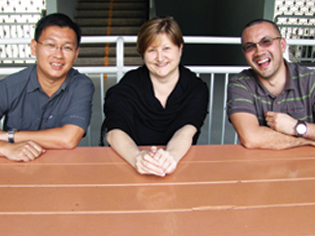Why Singapore’s English Teachers Should Embrace Singlish, Not Fight It
Is it time for Singaporean educators to embrace Singlish as a legitimate learning tool? What the Research […]
Read More
Traditional math classrooms typically see students quietly working hard at solving problems as the teacher makes her rounds to check that they are on task. What happens when we do away with the problem solving and start with the solutions instead?
Technology is part and parcel of the daily school life for students at the School of Science and Technology (SST). But it isn’t just the technology that is transforming the way they learn.
A team from NIE’s Learning Sciences Lab (LSL), led by Research Scientist Sarah Davis, has been exploring how we can foster critical thinking and deep understanding of math concepts with the support of highly collaborative technologies.
 They are particularly interested in seeing how interactions between the teacher and students change with the use of new technology.
They are particularly interested in seeing how interactions between the teacher and students change with the use of new technology.
“What we are focusing on are the types of activities that teachers can leverage to improve students’ talk and dialogue, communication and critical thinking, and what the classrooms will start to look like when technologies are being used,” says Sarah.
Sarah has introduced the use of a program called NetLogo for teaching Math at SST. The use of NetLogo enables teachers to transform Math classes into dynamic learning platforms through networked classroom activities.
The software is currently being applied to graphing type activities. It also has the ability to produce real-time synchronous feedback and interactions between teachers and their students.
With NetLogo, students can now generate their own graphs with ease and produce immediate visual representations. It has simplified the process of computation, and allowed students to focus on the mathematical explanations behind the calculation.
While still in its pilot phase, the math teachers at SST are already seeing how technology can change classroom interactions. One of the most significant changes is a shift in the classroom culture.
– Jason Ingham, Subject Head of Mathematics, School of Science and Technology
Jason Ingham, Subject Head of Mathematics, has noticed that his students now ask more questions – and he is glad for this.
“I have yet to go into a classroom without any questions raised. A lot of time is spent on discussing math concepts and reinforcing one another. Students get to reinforce their understanding of math concepts by spending time talking about it,” notes Jason.
Fellow math teacher Edmund Ng has also observed this in his classes. He notes that the quality of the interactions among the students has heightened.
“Often, in a conventional classroom, you will find it very difficult to engage your students in interactions because of the classroom size and the amount of control you want to exert over the class,” explains Edmund. “Using the network tools and activities, you could have simultaneous interactions at the same time.”
Such a shift in classroom culture has been possible because the use of technology drastically cuts down on the time needed for tedious and repetitive work. This includes plotting graphs and drawing representations, which Jason describes as procedural.
“The emphasis of the lesson can now be on the analysis of the graph rather than plotting it so a lot more time will actually be spent on looking at the conceptual aspect of things rather than the repetitive work of getting the graph right,” says Edmund. “So technology really helps with this.”
And because students have more time to explore, experiment and learn by themselves, they are able to pick up concepts by themselves. Jason notes, “Technology helps my students and me to look at math concepts from the high level first before moving down to the details.”
In addition to saving on time and gaining on understanding, Edmund says students need to find purpose in their learning, where they can relate math learning to the real world. Today’s technology makes it easy to bring up practical examples to interest and excite the students.
Technology can also be extremely powerful in improving students’ math learning because of the sense of ownership students have over their work.
“To them, this is something that they have created rather than forced on by their teachers. They see a purpose in using the product that they have created,” explains Edmund. “This part is important for them to really progress in their learning.”
– Sarah Davis, Learning Sciences Lab
Math lessons have never been so exciting. Technology offers choices for content and pedagogy never experienced before. But while software like NetLogo allows us to save a lot of precious lesson time, offering more opportunities for spontaneous conversations and activities, we have to remember it is also just a tool.
Sarah says that the key to improving learning in a Math classroom still boils down to the pedagogy, how teachers orchestrate their classes, and the types of questions they ask their students.
“Technology is more like a scaffolding and directing tool,” says Jason. “You can introduce ICT into your math lessons but you can also do it didactically, so it is down to the questioning techniques. Are the teachers able to know what to ask? When and how to ask questions in a way that scaffolds learning?”
So while the technology may be new, the goal of learning really hasn’t changed. Students need to feel that they can ask any question with no shame, say Jason and Edmund – technology has only helped to make this a little easier.